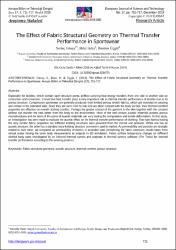| dc.contributor.author | Sertaç, Güney | |
| dc.contributor.author | Balcı, Hilal | |
| dc.contributor.author | Üçgül, İbrahim | |
| dc.date.accessioned | 2023-04-13T06:44:31Z | |
| dc.date.available | 2023-04-13T06:44:31Z | |
| dc.date.issued | 2019 | en_US |
| dc.identifier.citation | Güney, S., BALCI, H., & Üçgül, İ. (2019). The Effect of Fabrıc Structural Geometry on Thermal Transfer Performance in Sportswear. Avrupa Bilim ve Teknoloji Dergisi, (17), 711-717. | en_US |
| dc.identifier.issn | 2148-2683 | |
| dc.identifier.uri | https://doi.org/10.31590/ejosat.629477 | |
| dc.identifier.uri | https://hdl.handle.net/20.500.12294/3736 | |
| dc.description.abstract | Especially for textiles, which contain open structure pores, airflow carrying heat energy transfers from one side to another side by
conduction and convection. Convective heat transfer plays a very important role in thermal transfer performance of textiles due to its
porous structure. Compression sportswear are generally produced from knitted porous stretch fabrics, which get extended on wearing
and remain in the extended state. Since they are worn next to skin and are direct contact with the body surface, their thermal comfort
properties are effective on overall clothing comfort. Perhaps the greater contact of the garment to the skin together with the constant
airflow can transfer the heat better from the body to the environment. Most of the well-known auxetic materials possess porous
microstructures and the sizes of the pores of auxetic materials can vary during the compressive and tensile deformation. In this study,
an investigation has been made to evaluate the auxetic effect on the thermal transfer performance of clothing. Two type fabrics having
the very similar fabric properties but different knitting structures were provided from the market and producer. While one has an
auxetic structure, the other has a standard warp knitting structure commonly used in market. As permeability and porosity are strongly
related to each other, we compared air permeability of fabrics in extended state considering the fabric extension results taken from
virtual avatar having the same body measurements as subjects in 3D simulation. Fabric surface temperature changes on different
clothed body parts investigated by an infrared thermal camera and analysed in thermal camera software (Flir Tools) for thermal
transfer performance according to the wearing protocol. | en_US |
| dc.language.iso | eng | en_US |
| dc.publisher | Osman Sağdıç | en_US |
| dc.relation.ispartof | Avrupa Bilim ve Teknoloji Dergisi | en_US |
| dc.identifier.doi | 10.31590/ejosat.629477 | en_US |
| dc.rights | info:eu-repo/semantics/openAccess | en_US |
| dc.subject | Fabric Structural Geometry | en_US |
| dc.subject | Auxetic Structure | en_US |
| dc.subject | Thermal Comfort | en_US |
| dc.subject | Porous Structure | en_US |
| dc.title | The Effect of Fabric Structural Geometry on Thermal Transfer Performance in Sportswear | en_US |
| dc.type | article | en_US |
| dc.department | Meslek Yüksekokulu, Moda Tasarımı Programı | en_US |
| dc.authorid | 0000-0001-5442-8860 | en_US |
| dc.identifier.issue | 17 | en_US |
| dc.identifier.startpage | 711 | en_US |
| dc.identifier.endpage | 717 | en_US |
| dc.relation.publicationcategory | Makale - Ulusal Hakemli Dergi - Kurum Öğretim Elemanı | en_US |
| dc.institutionauthor | Balcı, Hilal | |


















